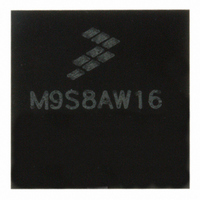MC9S08AW16MFGE Freescale Semiconductor, MC9S08AW16MFGE Datasheet - Page 196

MC9S08AW16MFGE
Manufacturer Part Number
MC9S08AW16MFGE
Description
IC MCU 8BIT 16K FLASH 44-LQFP
Manufacturer
Freescale Semiconductor
Series
HCS08r
Datasheet
1.MC9S08AW32CFDE.pdf
(324 pages)
Specifications of MC9S08AW16MFGE
Core Processor
HCS08
Core Size
8-Bit
Speed
40MHz
Connectivity
I²C, SCI, SPI
Peripherals
LVD, POR, PWM, WDT
Number Of I /o
34
Program Memory Size
16KB (16K x 8)
Program Memory Type
FLASH
Ram Size
1K x 8
Voltage - Supply (vcc/vdd)
2.7 V ~ 5.5 V
Data Converters
A/D 8x10b
Oscillator Type
Internal
Operating Temperature
-40°C ~ 125°C
Package / Case
44-LQFP
Lead Free Status / RoHS Status
Lead free / RoHS Compliant
Eeprom Size
-
Available stocks
Company
Part Number
Manufacturer
Quantity
Price
Company:
Part Number:
MC9S08AW16MFGE
Manufacturer:
Freescale Semiconductor
Quantity:
10 000
Part Number:
MC9S08AW16MFGE
Manufacturer:
FREESCALE
Quantity:
20 000
- Current page: 196 of 324
- Download datasheet (4Mb)
Chapter 11 Serial Communications Interface (S08SCIV2)
character(s) of each message, and as soon as they determine the message is intended for a different
receiver, they write logic 1 to the receiver wake up (RWU) control bit in SCIxC2. When RWU = 1, it
inhibits setting of the status flags associated with the receiver, thus eliminating the software overhead for
handling the unimportant message characters. At the end of a message, or at the beginning of the next
message, all receivers automatically force RWU to 0 so all receivers wake up in time to look at the first
character(s) of the next message.
11.3.3.2.1
When WAKE = 0, the receiver is configured for idle-line wakeup. In this mode, RWU is cleared
automatically when the receiver detects a full character time of the idle-line level. The M control bit selects
8-bit or 9-bit data mode that determines how many bit times of idle are needed to constitute a full character
time (10 or 11 bit times because of the start and stop bits).
When the RWU bit is set, the idle character that wakes a receiver does not set the receiver idle bit, IDLE,
or the receive data register full flag, RDRF. It therefore will not generate an interrupt when this idle
character occurs. The receiver will wake up and wait for the next data transmission which will set RDRF
and generate an interrupt if enabled.
The idle-line type (ILT) control bit selects one of two ways to detect an idle line. When ILT = 0, the idle
bit counter starts after the start bit so the stop bit and any logic 1s at the end of a character count toward
the full character time of idle. When ILT = 1, the idle bit counter does not start until after a stop bit time,
so the idle detection is not affected by the data in the last character of the previous message.
11.3.3.2.2
When WAKE = 1, the receiver is configured for address-mark wakeup. In this mode, RWU is cleared
automatically when the receiver detects a logic 1 in the most significant bit of a received character (eighth
bit in M = 0 mode and ninth bit in M = 1 mode).
Address-mark wakeup allows messages to contain idle characters but requires that the MSB be reserved
for use in address frames. The logic 1 MSB of an address frame clears the receivers RWU bit before the
stop bit is received and sets the RDRF flag.
11.3.4
The SCI system has three separate interrupt vectors to reduce the amount of software needed to isolate the
cause of the interrupt. One interrupt vector is associated with the transmitter for TDRE and TC events.
Another interrupt vector is associated with the receiver for RDRF and IDLE events, and a third vector is
used for OR, NF, FE, and PF error conditions. Each of these eight interrupt sources can be separately
masked by local interrupt enable masks. The flags can still be polled by software when the local masks are
cleared to disable generation of hardware interrupt requests.
The SCI transmitter has two status flags that optionally can generate hardware interrupt requests. Transmit
data register empty (TDRE) indicates when there is room in the transmit data buffer to write another
transmit character to SCIxD. If the transmit interrupt enable (TIE) bit is set, a hardware interrupt will be
requested whenever TDRE = 1. Transmit complete (TC) indicates that the transmitter is finished
transmitting all data, preamble, and break characters and is idle with TxD high. This flag is often used in
196
Interrupts and Status Flags
Idle-Line Wakeup
Address-Mark Wakeup
MC9S08AW60 Data Sheet, Rev 2
Freescale Semiconductor
Related parts for MC9S08AW16MFGE
Image
Part Number
Description
Manufacturer
Datasheet
Request
R
Part Number:
Description:
Manufacturer:
Freescale Semiconductor, Inc
Datasheet:
Part Number:
Description:
Manufacturer:
Freescale Semiconductor, Inc
Datasheet:
Part Number:
Description:
Manufacturer:
Freescale Semiconductor, Inc
Datasheet:
Part Number:
Description:
Manufacturer:
Freescale Semiconductor, Inc
Datasheet:
Part Number:
Description:
Manufacturer:
Freescale Semiconductor, Inc
Datasheet:
Part Number:
Description:
Manufacturer:
Freescale Semiconductor, Inc
Datasheet:
Part Number:
Description:
Manufacturer:
Freescale Semiconductor, Inc
Datasheet:
Part Number:
Description:
Manufacturer:
Freescale Semiconductor, Inc
Datasheet:
Part Number:
Description:
Manufacturer:
Freescale Semiconductor, Inc
Datasheet:
Part Number:
Description:
Manufacturer:
Freescale Semiconductor, Inc
Datasheet:
Part Number:
Description:
Manufacturer:
Freescale Semiconductor, Inc
Datasheet:
Part Number:
Description:
Manufacturer:
Freescale Semiconductor, Inc
Datasheet:
Part Number:
Description:
Manufacturer:
Freescale Semiconductor, Inc
Datasheet:
Part Number:
Description:
Manufacturer:
Freescale Semiconductor, Inc
Datasheet:
Part Number:
Description:
Manufacturer:
Freescale Semiconductor, Inc
Datasheet:











